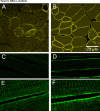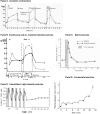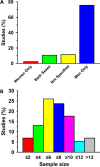A century of exercise physiology: effects of muscle contraction and exercise on skeletal muscle Na+,K+-ATPase, Na+ and K+ ions, and on plasma K+ concentration-historical developments
- PMID: 38206444
- PMCID: PMC10879387
- DOI: 10.1007/s00421-023-05335-9
A century of exercise physiology: effects of muscle contraction and exercise on skeletal muscle Na+,K+-ATPase, Na+ and K+ ions, and on plasma K+ concentration-historical developments
Abstract
This historical review traces key discoveries regarding K+ and Na+ ions in skeletal muscle at rest and with exercise, including contents and concentrations, Na+,K+-ATPase (NKA) and exercise effects on plasma [K+] in humans. Following initial measures in 1896 of muscle contents in various species, including humans, electrical stimulation of animal muscle showed K+ loss and gains in Na+, Cl- and H20, then subsequently bidirectional muscle K+ and Na+ fluxes. After NKA discovery in 1957, methods were developed to quantify muscle NKA activity via rates of ATP hydrolysis, Na+/K+ radioisotope fluxes, [3H]-ouabain binding and phosphatase activity. Since then, it became clear that NKA plays a central role in Na+/K+ homeostasis and that NKA content and activity are regulated by muscle contractions and numerous hormones. During intense exercise in humans, muscle intracellular [K+] falls by 21 mM (range - 13 to - 39 mM), interstitial [K+] increases to 12-13 mM, and plasma [K+] rises to 6-8 mM, whilst post-exercise plasma [K+] falls rapidly, reflecting increased muscle NKA activity. Contractions were shown to increase NKA activity in proportion to activation frequency in animal intact muscle preparations. In human muscle, [3H]-ouabain-binding content fully quantifies NKA content, whilst the method mainly detects α2 isoforms in rats. Acute or chronic exercise affects human muscle K+, NKA content, activity, isoforms and phospholemman (FXYD1). Numerous hormones, pharmacological and dietary interventions, altered acid-base or redox states, exercise training and physical inactivity modulate plasma [K+] during exercise. Finally, historical research approaches largely excluded female participants and typically used very small sample sizes.
Keywords: Exercise; FXYD; Fatigue; Na+, K+-pump; Plasma; Potassium; Skeletal muscle; Sodium.
© 2024. The Author(s).
Figures









Similar articles
-
Inactivity and exercise training differentially regulate abundance of Na+-K+-ATPase in human skeletal muscle.J Appl Physiol (1985). 2019 Oct 1;127(4):905-920. doi: 10.1152/japplphysiol.01076.2018. Epub 2019 Aug 1. J Appl Physiol (1985). 2019. PMID: 31369327 Review.
-
Acute oral digoxin in healthy adults hastens fatigue and increases plasma K+ during intense exercise, despite preserved skeletal muscle Na+,K+-ATPase.J Physiol. 2024 Dec;602(24):6849-6869. doi: 10.1113/JP287274. Epub 2024 Nov 23. J Physiol. 2024. PMID: 39580613 Clinical Trial.
-
Oral digoxin effects on exercise performance, K+ regulation and skeletal muscle Na+ ,K+ -ATPase in healthy humans.J Physiol. 2022 Aug;600(16):3749-3774. doi: 10.1113/JP283017. Epub 2022 Aug 2. J Physiol. 2022. PMID: 35837833 Free PMC article. Clinical Trial.
-
Dissociation between short-term unloading and resistance training effects on skeletal muscle Na+,K+-ATPase, muscle function, and fatigue in humans.J Appl Physiol (1985). 2016 Nov 1;121(5):1074-1086. doi: 10.1152/japplphysiol.00558.2016. Epub 2016 Sep 15. J Appl Physiol (1985). 2016. PMID: 27633740
-
Na,K-ATPase regulation in skeletal muscle.Am J Physiol Endocrinol Metab. 2016 Jul 1;311(1):E1-E31. doi: 10.1152/ajpendo.00539.2015. Epub 2016 May 10. Am J Physiol Endocrinol Metab. 2016. PMID: 27166285 Review.
Cited by
-
Diffusive to Barrier-Limited Transition in the Aqueous Ion Transport through Nanoporous 2D Materials.J Phys Chem B. 2025 May 15;129(19):4851-4859. doi: 10.1021/acs.jpcb.5c00921. Epub 2025 May 6. J Phys Chem B. 2025. PMID: 40327550 Free PMC article.
-
Fatiguing high-intensity intermittent exercise depresses maximal Na+-K+-ATPase activity in human skeletal muscle assessed using a novel NADH-coupled assay.Pflugers Arch. 2025 Feb;477(2):303-316. doi: 10.1007/s00424-024-03036-6. Epub 2024 Nov 14. Pflugers Arch. 2025. PMID: 39540939 Free PMC article.
-
Exercise and fatigue: integrating the role of K+, Na+ and Cl- in the regulation of sarcolemmal excitability of skeletal muscle.Eur J Appl Physiol. 2023 Nov;123(11):2345-2378. doi: 10.1007/s00421-023-05270-9. Epub 2023 Aug 16. Eur J Appl Physiol. 2023. PMID: 37584745 Free PMC article. Review.
-
Exercise is medicine, or exercise with medicine? Comparative effects on Na+,K+-ATPase regulation.Exp Physiol. 2024 Nov;109(11):1815-1816. doi: 10.1113/EP092247. Epub 2024 Sep 30. Exp Physiol. 2024. PMID: 39344687 Free PMC article. No abstract available.
-
Ouabain Ameliorates Alzheimer's Disease-Associated Neuropathology and Cognitive Impairment in FAD4T Mice.Nutrients. 2024 Oct 20;16(20):3558. doi: 10.3390/nu16203558. Nutrients. 2024. PMID: 39458551 Free PMC article.
References
-
- Ahlborg B, Bergström J, Ekelund L, Hultman E. Muscle glycogen and muscle electrolytes during prolonged physical exercise. Acta Physiol Scand. 1967;70:129–142. doi: 10.1111/j.1748-1716.1967.tb03608.x. - DOI
Publication types
MeSH terms
Substances
LinkOut - more resources
Full Text Sources

